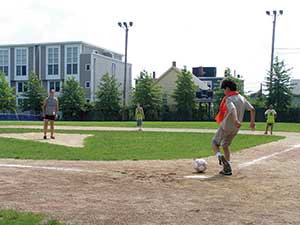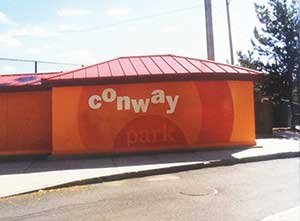
Traces of soil contaminants have been found on the grounds at Conway field and playground, forcing its continued closure until a full cleanup is completed.
By Kalina Newman
Conway field and playground will remain shut down, after risk assessors from Watson & Sampson, an environmental service company, along with The City of Somerville Parks and Recreation, examined soil solutions around the playground. Representatives from Watson & Sampson met with the public last Tuesday to discuss their findings.
The playground shutdown continues more so out of caution than immediate risk. After primary data examination, only two sections of the park contain surface-level amounts soil with amounts of lead and poly-chlorinated biphenyls that exceed state regulatory limits. However, upon further testing, the amounts present have proven to be extremely low-risk for possibility of human contamination, through either ingestion or dermal exposure. Levels of soil exposure were tested using a population sample that would be theoretically be present at the park once a week, for 24 hours at a time, for a year.
“We’re going to continue to do more evaluation of the surface soil, but essentially there is no imminent hazard associated with exposure,” said Marie Rudiman at the meeting, a senior risk assessor with Watson & Sampson.
 Conway Field and Playground has been scheduled for renovation for over a year. The soil contaminants were discovered when the field was tested out of caution due to its background. According to George Naslas, Vice President and environmental practice leader of Watson & Sampson, The Conway Field and Playground site was formerly a bleach and dye facility. In addition, the playground is also located to a since-defunct smelting company, Bay State Smelting.
Conway Field and Playground has been scheduled for renovation for over a year. The soil contaminants were discovered when the field was tested out of caution due to its background. According to George Naslas, Vice President and environmental practice leader of Watson & Sampson, The Conway Field and Playground site was formerly a bleach and dye facility. In addition, the playground is also located to a since-defunct smelting company, Bay State Smelting.
“We recognized because of the proximity to Bay State Smelting that we might have some contaminants, which is why we began testing,” said Naslas.
It’s unsure right now when the park will be back open to the public, but there will be further soil testing and the ultimate goal of a field renovation.
“We’re not saying we’re done, but this is the first step. The next steps are to evaluate, in more detail, the contaminants that could potentially be further around the site,” said Naslas. Watson & Sampson will continue to sample in the areas of the park where higher level of contaminants were found, which came out to be 14 parts per million of PCBs.
















Reader Comments